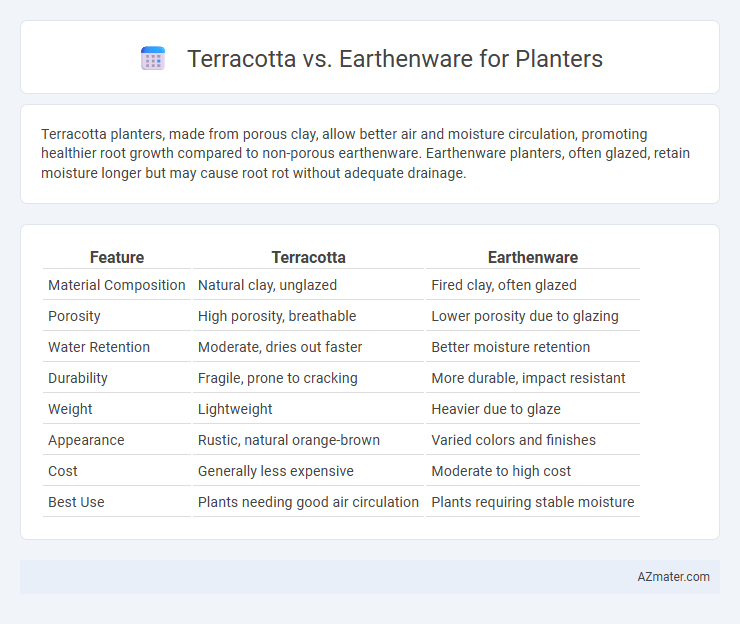Terracotta planters, made from porous clay, allow better air and moisture circulation, promoting healthier root growth compared to non-porous earthenware. Earthenware planters, often glazed, retain moisture longer but may cause root rot without adequate drainage.
Table of Comparison
| Feature | Terracotta | Earthenware |
|---|---|---|
| Material Composition | Natural clay, unglazed | Fired clay, often glazed |
| Porosity | High porosity, breathable | Lower porosity due to glazing |
| Water Retention | Moderate, dries out faster | Better moisture retention |
| Durability | Fragile, prone to cracking | More durable, impact resistant |
| Weight | Lightweight | Heavier due to glaze |
| Appearance | Rustic, natural orange-brown | Varied colors and finishes |
| Cost | Generally less expensive | Moderate to high cost |
| Best Use | Plants needing good air circulation | Plants requiring stable moisture |
Understanding Terracotta and Earthenware: A Brief Overview
Terracotta planters, made from porous, reddish clay, offer excellent breathability and moisture regulation for plant roots, promoting healthy growth. Earthenware planters, typically glazed and less porous, provide a wider range of colors and designs but retain more moisture, which can lead to root rot if not monitored. Understanding these material properties helps gardeners choose the right planter based on plant type and watering habits.
Composition and Manufacturing Differences
Terracotta planters are made from clay with a high iron content, fired at lower temperatures around 1,000degC, resulting in a porous, reddish-brown material ideal for breathability and moisture regulation. Earthenware planters also use clay, but often incorporate additional minerals and are fired at slightly higher temperatures, producing a denser, less porous surface that can be glazed for enhanced durability. The distinct firing processes and raw material compositions influence their water retention, weight, and suitability for different plant types.
Visual and Aesthetic Appeal
Terracotta planters exhibit a warm, natural reddish-brown hue with a porous matte texture that enhances plant presentation through rustic charm and timeless elegance. Earthenware planters provide a broader palette with glazed finishes, offering vibrant colors and glossy surfaces that create striking focal points in garden or indoor settings. The visual appeal of terracotta lies in its organic simplicity, while earthenware captivates with artistic versatility and decorative detailing.
Porosity and Water Retention Capabilities
Terracotta planters exhibit higher porosity, allowing for excellent airflow and moderate moisture evaporation, which helps prevent root rot but requires more frequent watering. Earthenware planters have lower porosity, retaining water longer and providing consistent moisture levels ideal for plants needing steady hydration. The choice between terracotta and earthenware depends on balancing water retention needs against soil aeration and drainage preferences.
Durability and Weather Resistance
Terracotta planters offer moderate durability with porous material that can absorb moisture, making them prone to cracking in freezing weather. Earthenware planters, often glazed, provide enhanced weather resistance by minimizing water absorption and improving frost tolerance. For outdoor use in variable climates, earthenware offers superior protection while terracotta remains favored for its natural breathability and aesthetic appeal.
Suitability for Indoor vs Outdoor Use
Terracotta planters offer excellent breathability and natural insulation, making them ideal for outdoor use where temperature fluctuations occur; however, their porous nature can lead to cracking in freezing conditions. Earthenware planters, often glazed, are better suited for indoor environments as the glaze reduces water absorption and prevents leakage, maintaining moisture levels for houseplants. Both materials provide aesthetic appeal, but terracotta excels outdoors due to durability in warm climates, while earthenware is preferred indoors for its decorative finish and moisture retention.
Plant Health Considerations
Terracotta planters offer excellent breathability and moisture regulation, promoting healthier root systems by preventing waterlogging and root rot. Earthenware planters, often glazed, retain more moisture and may limit air circulation, which can increase the risk of root diseases in some plant types. Selecting between terracotta and earthenware depends on the specific water and aeration needs of the plant species to support optimal growth and health.
Weight and Portability Factors
Terracotta planters are denser and heavier than earthenware, making them less portable but more stable for larger plants. Earthenware planters are lighter and easier to move, ideal for gardeners who frequently rearrange their indoor or outdoor spaces. Weight differences impact watering frequency and risk of tipping, with terracotta offering durability under wind exposure and earthenware suited to mobility and decorative versatility.
Cost and Availability Comparison
Terracotta planters are generally more expensive than earthenware due to their firing process and durability, with prices ranging from $15 to $50 depending on size and design, whereas earthenware tends to be cheaper, often available under $20. Both materials are widely available in garden centers and online, but terracotta is preferred for its classic aesthetic and breathability, making it a common choice among gardening enthusiasts. Earthenware planters offer a budget-friendly alternative but may lack the longevity and water retention efficiency found in terracotta options.
Which is Better: Choosing the Right Planter for Your Needs
Terracotta planters offer excellent breathability and moisture regulation, making them ideal for plants that prefer well-aerated soil, whereas earthenware planters provide a more decorative appeal with their glazed surface, which retains moisture longer and reduces evaporation. The choice depends on your plant type and watering habits: terracotta is better suited for drought-tolerant plants, while earthenware works well for moisture-loving plants requiring consistent hydration. Considering weight and durability, terracotta is lighter and more fragile, while earthenware is heavier and often more resilient to weathering.

Infographic: Terracotta vs Earthenware for Planter
 azmater.com
azmater.com